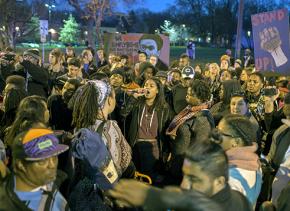On the road for justice in Minneapolis
reports on the protests that have followed in the wake of case example of police violence in the Twin Cities, as activists demand to see the facts for themselves.
MORE THAN 50 people were arrested in Minneapolis for blocking Interstate 94 as anger erupted at the police shooting of 24-year-old Jamar Clark on November 14.
As this story was being written, large numbers of police had arrived to clear an activist encampment set up on the lawn in front of the Fourth Precinct since the day Clark was killed--but daily demonstrations did continue. The occupation and subsequent protests are designed to pressure authorities to meet a series of demands, including releasing video footage of the incident.
Clark was shot in a confrontation with police on a residential street in North Minneapolis. The cops claim they stopped Clark in connection to an assault, and the head of the police union is claiming to reporters that Clark went for the weapon of one of the two officers involved. But witnesses tell a very different story--with many insisting they saw that Clark was handcuffed when the officer's gun was fired.
Clark died on Monday night after being taken off life support at a local hospital.

There is video of the shooting from several sources, including public housing security cameras and cell phone footage from witnesses. But the Minnesota Bureau of Criminal Apprehension (BCA), which is investigating the killing, has defied calls from activists to release the footage it has gathered, claiming that this might interfere with its inquiry.
In addition to calling for the release of the video footage, activists are calling for an independent organization to investigate the shooting, rather than BCA; for media representations that include the testimony of witnesses, instead of just police; for community oversight of the police; and for police to live in the communities where they are assigned.
BEFORE THE sit-in on Interstate 94, several hundred people gathered for a rally before marching to the highway, which was shut down for several hours.
Quay, a young woman who would be among those arrested in a few hours, said she was at the protest because she worries about her two younger brothers, one of whom is frequently approached by the police for reasons of "mistaken identity." She emphasized the importance of the BCA releasing the footage so people can see what really happened.
Mona Abdi, who originally hails from Nairobi, Kenya, says she worries about her two sons, aged 8 and 10, who live in the same neighborhood where Clark was killed. "This could have been them," she said.
Nearby was Gayla, who wore a sweatshirt with a silk-screened picture of her son, who she came to the protest to honor, she said. In 2012, he was killed six days before his 21st birthday, shot in the back of the head by a police officer in neighboring St. Paul. Though reluctant to go into detail since she has filed suit against the authorities, Gayla said that her son was killed while allegedly robbing a store, but that witnesses dispute the police version of the shooting, just as they do in Jamar Clark's case.
One major concern among both speakers and those listening in the crowd is the media's representation of the Black community. One woman used the bullhorn to express anger that Blacks are routinely described as "criminals" and "thugs." She said that information about the day's protest would be spread alternatively, through Twitter, Facebook and a livestream being provided by Unicorn Riot.
The rally ended with a plea for people to remain vigilant against police violence and ready to provide support when police inevitably tried to clear the Fourth Precinct occupation.
The crowd then marched to Interstate 94 and a group of protesters blocked traffic. The demonstrators faced a force of more than 100 state troopers, who eventually moved in and made arrests after giving a warning.
Those who made the decision to leave the freeway before arrests began marched back to the Fourth Precinct, stopping to join hands and share a moment of silence at the place where Jamar was killed.
Among those who were arrested, spending the night in a jail cell turned into a bonding experiences--one that quickly turned strangers into comrades. The arrestees, which included eight people under age 18, were loaded onto police buses and taken to a downtown precinct.
There were conversations about a variety of topics throughout the night: whether Jamar Clark's murder would spark a movement like Mike Brown's did in Ferguson; what kind of role did police play; how was the issue of the violence of militarized police connected to U.S. wars overseas; what had happened in the attacks in Lebanon, Paris and Lebanon.
By 5 a.m., all of those arrested had been released. Outside the precinct, they were greeted by a "prison support" team. The feeling among people in those early morning hours was that a corner had been turned--and that the movement to win justice for Jamar Clark would continue.


